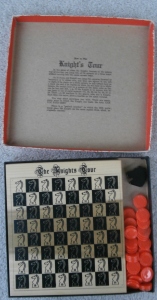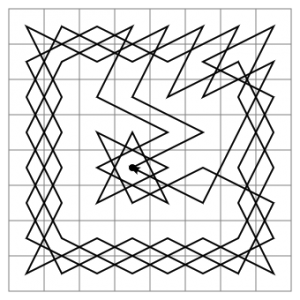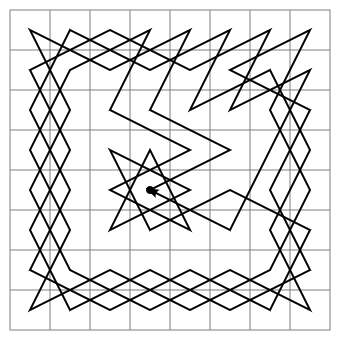 In amongst my collection of games is a solitary game called The Knight’s Tour. It is an intriguing puzzle that I like to bring out once in a while to test my patience. Sometimes, I put it back on the shelf pretty quick. Other times, I can sit and play for quite a time. It all depends. 🙂
In amongst my collection of games is a solitary game called The Knight’s Tour. It is an intriguing puzzle that I like to bring out once in a while to test my patience. Sometimes, I put it back on the shelf pretty quick. Other times, I can sit and play for quite a time. It all depends. 🙂
What I find most interesting about the Knight’s Tour, however, is its solution method and its involvement in the coded message of the Rennes le Chateau mystery.
The Knight’s Tour challenges a person to move the Knight of a chess game across its 8×8 board so that it only lands on a square once during its circuit. Because of the knight’s way of moving, it is able to jump on to all 64 squares without touching any twice. There are actually multiple solutions for the puzzle, and the varying paths the Knight takes creates curious patterns.
The first known reference to this Knight’s charm dates back to the 9th century. Later, it is seen referenced in the Book of Games written in 1283. I include that reference below:
“The knight has a greater advantage than all the chess men except the rook because he who knows how to play well with the knight by moving him from the first square on the edge of the board will capture as many pieces as there may be in all the squares of the board which are sixty-three without the square from where he began, because he never fails to capture according to his movement.”
In the Book of Games the Horse/Knight of the chess game is said to protect, looking both ways, and choosing the best, in order to conquer their enemies. Chess was based on actual war, and so the movements of the pieces in the game reflected movements of men in war.
In movement, the Horse was a combination of the Bishop and Rook pieces. The Horse moved straight (like the Rook) and diagonal (like the Bishop) as is stated in the description of his path in the Book of Games: ‘The knight jumps three square counting the one straight and taking the third diagonally of any direction.’ It could even be said the Horse is a pathway between the Earth and Heaven, since the Rook is associated with the Castle (earth) and the Bishop is associated with the Church (Heaven). He also rests between the two.
 It is intriguing then to find the Knight’s Tour as a deciphering method for one of the unexplained Rennes le Chateau parchment’s messages. Although these actual parchments are not considered ‘authentic’, the coding and decoding of the message, and the message itself, are believed to hold possible meanings. The ‘hoaxers’ of the parchments may have actually used authentic methods from earlier writings.
It is intriguing then to find the Knight’s Tour as a deciphering method for one of the unexplained Rennes le Chateau parchment’s messages. Although these actual parchments are not considered ‘authentic’, the coding and decoding of the message, and the message itself, are believed to hold possible meanings. The ‘hoaxers’ of the parchments may have actually used authentic methods from earlier writings.
The hidden message of the ‘Grand Parchment’ of RLC was revealed after the letters of the already partially decoded message were placed on two chessboards and a certain Knight’s Tour followed. This path provided the message most commonly translated as:
“Shepherdess no temptation that poussin teniers hold the key peace 681 by the cross and this horse of God I complete/destroy this daemon guardian at midday blue apples”
While playing the Knight’s Tour; moving the Knight over the black and white squares of the board, I often ask myself the questions, ‘why did the ‘Priory of Sion’ include this fascinating puzzle into their encryptions? Could it have a deeper meaning then a mere arrangement of letters? Could the process of unveiling the message—could this Knight’s Tour hold more importance than the message it states?’
It’s possible those answers may never be known. But even so, I can still have fun with my Knight’s Tour and try to win the game.
Best of luck with whatever you seek!


Pingback: Thoughts and Findings related to the Maranatha "Key" Pt. II - Page 22
Pingback: A Journey - Page 1167
Pingback: The 24 Puzzle and Game of Seven Sleepers » Mysterious Writings
I’m not sure about that connection of the knight with earth and heaven. But I’m pretty certain that the knight represents the level of the apprentice in freemasonry.
This comment was an inspired guess at the time, but now I know for a fact that understanding the chess knight is among the first things the apprentice needs to learn.
Why did the Priory of Sion include a knight’s tour into their encryptions? My best guess is that they were aware of the significance of the knight’s move in freemasonry, and that’s why they wanted to use it in their encryption. The knight makes a right-angle triangle of sides 1 and 2 as it moves. This gives a hypotenuse equal to the square root of five, essential to build the golden mean.